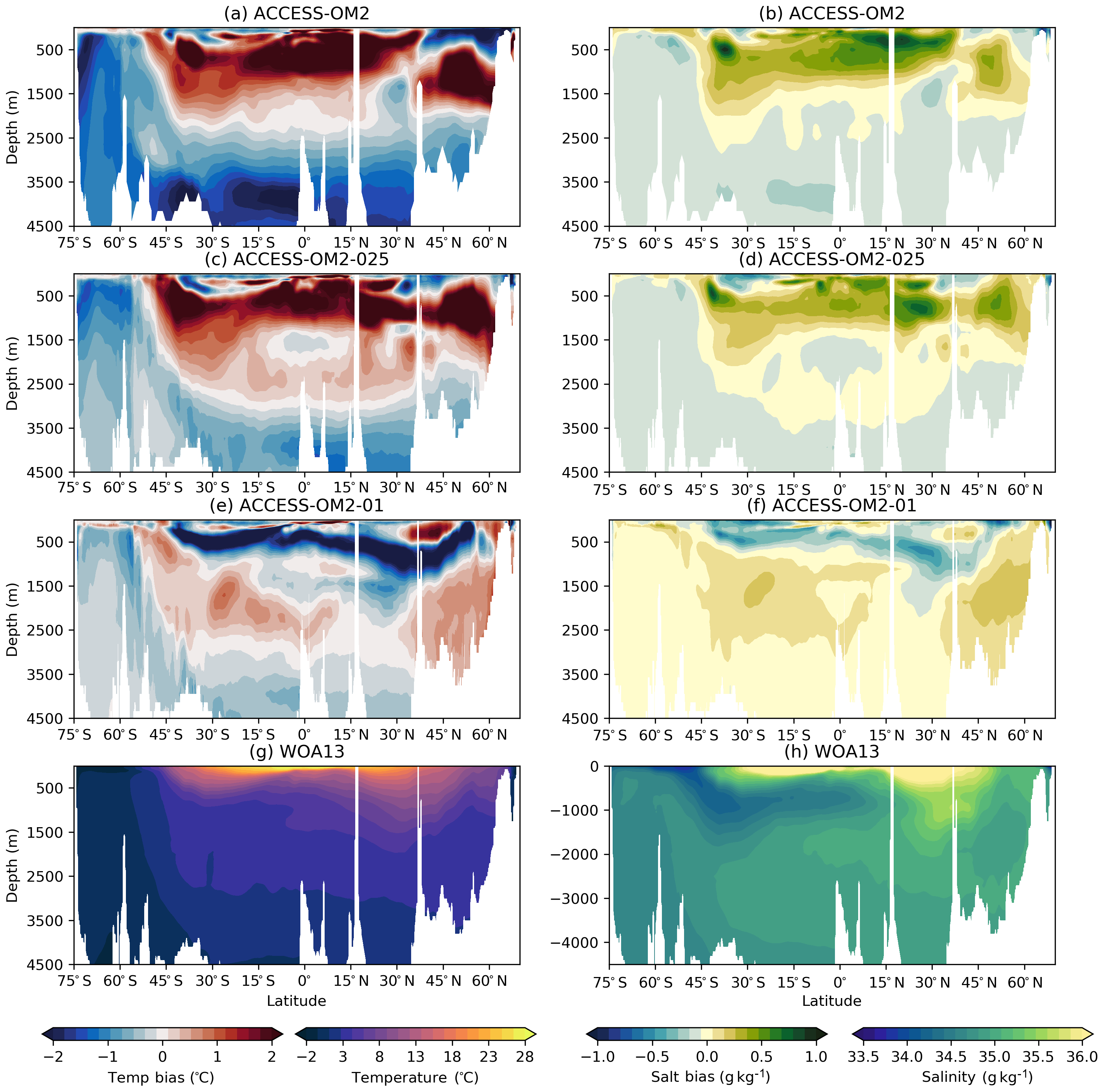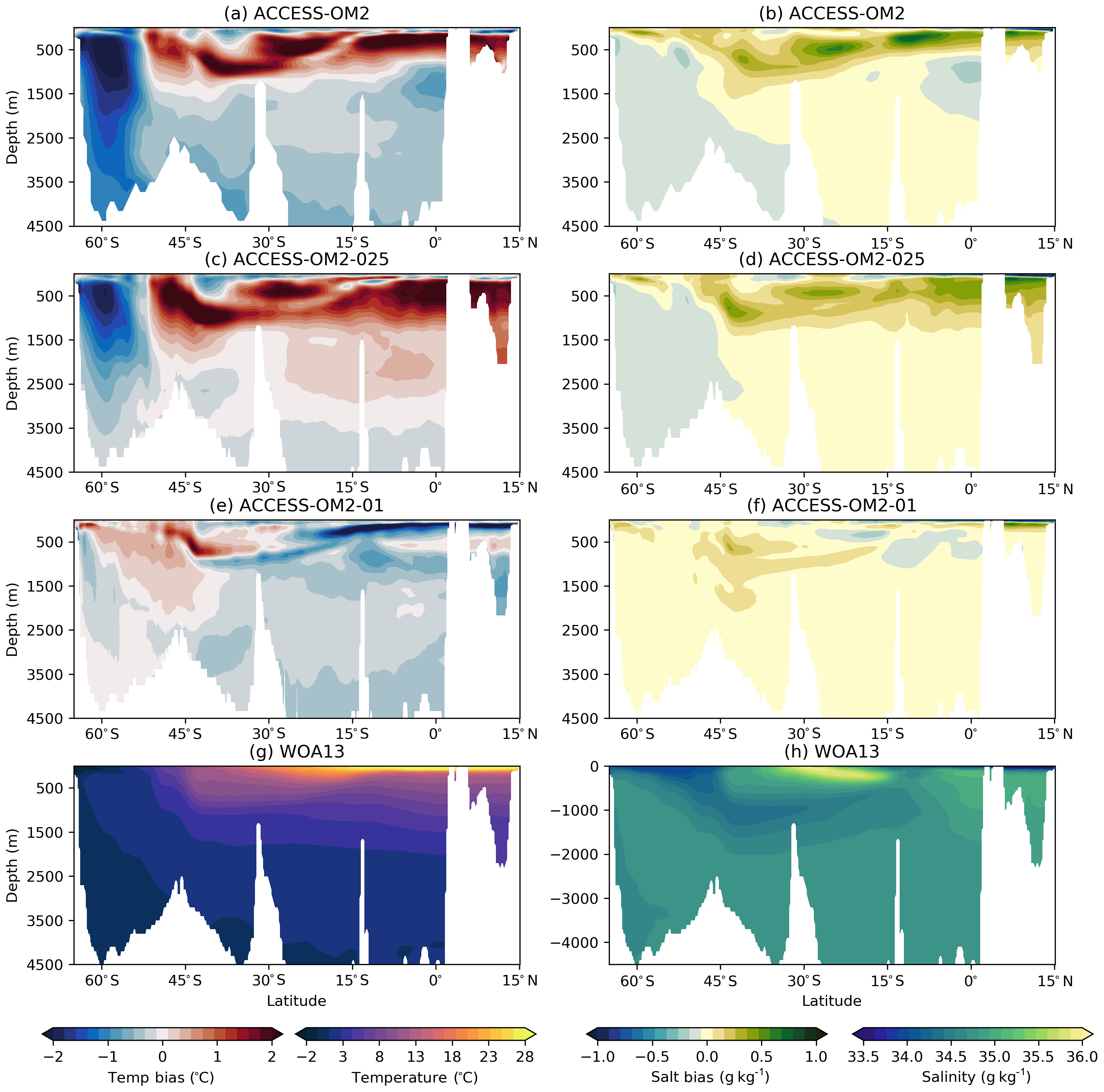In the paper we noted the excessively sharp tropical thermocline in ACCESS-OM2-01 and attributed it to the lack of explicit vertical diffusion and (presumably) reduced numerical diffusion in this run.
RYF spinup 7 (/g/data3/hh5/tmp/cosima/access-om2-01/01deg_jra55v13_ryf8485_spinup7) was a test run for new 0.1-degree spinup, which used a constant background vertical diffusivity of 1e-6
&ocean_vert_mix_nml
j09_diffusivity = .true.
j09_bgmin = 1.0e-6
j09_bgmax = 1.0e-6
j09_lat = 20.0Here's how the mean of the last 10 years of 01deg_jra55v13_ryf8485_spinup7 compares to 1998-2017 in the IAF runs. There was vertical diffusivity in the 1-degree run but not in the 0.25 or 0.1 deg IAF runs. The 0.1-deg runs had KDS75, whereas the others were KDS50. Spinup 7 was only a 20-year run, so only had 10 years to diverge from the WOA initial condition before the 10-year averaging period. Some differences may also be due to the differing forcing (84-85 RYF rather than IAF).
None of the profiles is particularly close to the observational estimate at 0N, -140E. Spinup 7 is closer than ACCESS-OM2-01 to the 1 and 0.25-deg profiles below ~120m, but more different (and mostly further from obs) in shallower regions. The temperature gradient is not much different from before, i.e. still much steeper than obs. It is remarkable how similar the 1 and 0.25-deg are, given that 1-deg has explicit vertical diffusivity and 0.25 doesn't (but presumably more numerical diffusivity than 0.1-deg).
It's unclear whether this superficial comparison with a short RYF run provides enough evidence to decide whether adding explicit vertical diffusivity is a good idea. But it looks relatively benign at least.
The plot notebook is here if anyone wants to dig deeper: https://github.com/aekiss/notebooks/blob/master/Equatorial_Pacific-spinup7.ipynb






 Figure 9: Horizontally averaged temperature anomaly (C) relative to WOA13 as a function of depth and time over the last interannual forcing cycle for (a) ACCESS-OM2, (b) ACCESS-OM2-025, and (c) ACCESS-OM2-01. Panels (a) and (b) are annual means, and (c) shows monthly means.
Figure 9: Horizontally averaged temperature anomaly (C) relative to WOA13 as a function of depth and time over the last interannual forcing cycle for (a) ACCESS-OM2, (b) ACCESS-OM2-025, and (c) ACCESS-OM2-01. Panels (a) and (b) are annual means, and (c) shows monthly means. Figure 12: Zonally averaged temperature bias relative to WOA13 for (a) ACCESS-OM2, (c) ACCESS-OM2-025, and (e) ACCESS-OM2-01. Zonally averaged salinity bias relative to WOA13 for (b) ACCESS-OM2, (d) ACCESS-OM2-025, and (f) ACCESS-OM2-01. The WOA13 zonally averaged temperature field is shown in (g), and the WOA13 zonally averaged salinity field is shown in (h). Model fields are 1993–2017 means.
Figure 12: Zonally averaged temperature bias relative to WOA13 for (a) ACCESS-OM2, (c) ACCESS-OM2-025, and (e) ACCESS-OM2-01. Zonally averaged salinity bias relative to WOA13 for (b) ACCESS-OM2, (d) ACCESS-OM2-025, and (f) ACCESS-OM2-01. The WOA13 zonally averaged temperature field is shown in (g), and the WOA13 zonally averaged salinity field is shown in (h). Model fields are 1993–2017 means. Figure 20: Meridional transects of 1993–2017 mean potential temperature (upper panels) and salinity (lower panels) in the central Pacific Ocean, along longitude 150W, near the WOCE/GO-SHIP hydrographic line P16 for (a–b) ACCESS-OM2, (c–d) ACCESS-OM2-025, (e–f) ACCESS-OM2-01, and (g–h) gridded climatologies from WOA13 for the period 1985–2013.
Figure 20: Meridional transects of 1993–2017 mean potential temperature (upper panels) and salinity (lower panels) in the central Pacific Ocean, along longitude 150W, near the WOCE/GO-SHIP hydrographic line P16 for (a–b) ACCESS-OM2, (c–d) ACCESS-OM2-025, (e–f) ACCESS-OM2-01, and (g–h) gridded climatologies from WOA13 for the period 1985–2013. Figure 19: Comparison of temperature (colour and contours every 1 C) and zonal velocity (white contours every 10 cm s−1 with black labels in centimetres per second) along the Equator (left) and at 220 E (right) in the Pacific for (a–b) ACCESS-OM2, (c–d) ACCESS-OM2-025, (e–f) ACCESS-OM2-01, and (g–h) observations (Johnson et al., 2002).
Figure 19: Comparison of temperature (colour and contours every 1 C) and zonal velocity (white contours every 10 cm s−1 with black labels in centimetres per second) along the Equator (left) and at 220 E (right) in the Pacific for (a–b) ACCESS-OM2, (c–d) ACCESS-OM2-025, (e–f) ACCESS-OM2-01, and (g–h) observations (Johnson et al., 2002). Figure 23: Meridional transects of 1993–2017 mean potential temperature (left panels) and salinity (right panels) in the central Atlantic Ocean, along longitude 25 W, near the WOCE/GO-SHIP hydrographic line A16 for (a–b) ACCESS-OM2, (c–d) ACCESS-OM2-025, (e–f) ACCESS-OM2-01, and (g–h) gridded climatologies from WOA13 for the period 1985–2013.
Figure 23: Meridional transects of 1993–2017 mean potential temperature (left panels) and salinity (right panels) in the central Atlantic Ocean, along longitude 25 W, near the WOCE/GO-SHIP hydrographic line A16 for (a–b) ACCESS-OM2, (c–d) ACCESS-OM2-025, (e–f) ACCESS-OM2-01, and (g–h) gridded climatologies from WOA13 for the period 1985–2013. Figure 25: Meridional transects of 1993–2017 mean potential temperature (upper panels) and salinity (lower panels) in the central Indian Ocean, along longitude 95 E, near the WOCE/GO-SHIP hydrographic lines I08 and I09 for (a–b) ACCESS-OM2, (c–d) ACCESS-OM2-025, (e–f) ACCESS-OM2-01, and (g–h) gridded climatologies from WOA13 for the period 1985–2013.
Figure 25: Meridional transects of 1993–2017 mean potential temperature (upper panels) and salinity (lower panels) in the central Indian Ocean, along longitude 95 E, near the WOCE/GO-SHIP hydrographic lines I08 and I09 for (a–b) ACCESS-OM2, (c–d) ACCESS-OM2-025, (e–f) ACCESS-OM2-01, and (g–h) gridded climatologies from WOA13 for the period 1985–2013. Figure 26: Annual mean depth of the 20 C isotherm (D20). (a) ACCESS-OM2; (b) ACCESS-OM2-025; (c) ACCESS-OM2-01; and (d) WOA13. The black box (50–75 E, 5–10 S) represents the position of the shallowest D20, which is used as a proxy for the thermocline ridge.
Figure 26: Annual mean depth of the 20 C isotherm (D20). (a) ACCESS-OM2; (b) ACCESS-OM2-025; (c) ACCESS-OM2-01; and (d) WOA13. The black box (50–75 E, 5–10 S) represents the position of the shallowest D20, which is used as a proxy for the thermocline ridge.
This would be for consistency with the new 0.1-degree run.
A constant background diffusivity of 1e-6 would improve the simulation of the equatorial thermocline (as tested in some MOM-SIS runs) without changing things much in the mid-latitudes (observations would suggest a value of 1e-5 in the mid-latitudes).